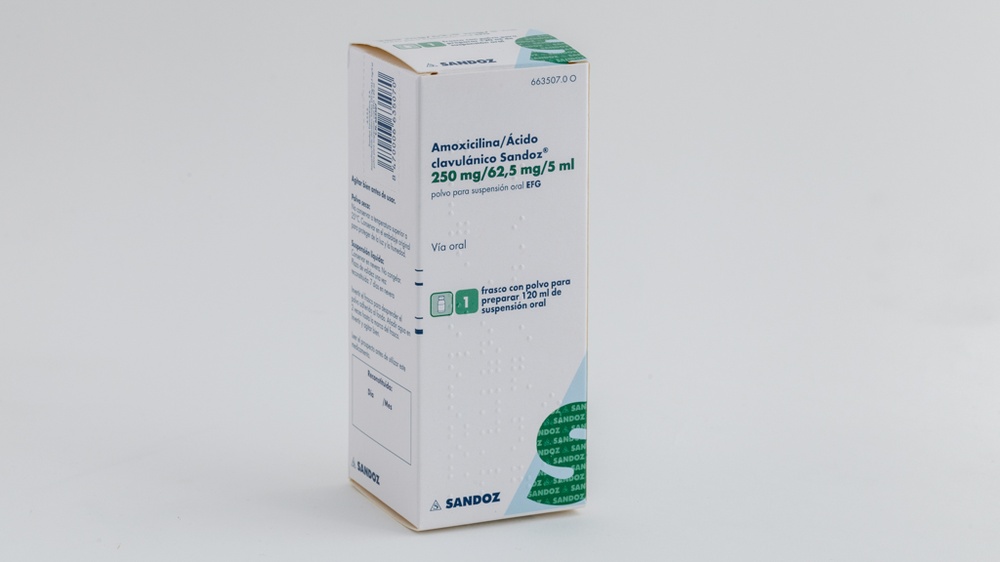

АМОКСИЦИЛІН / КЛАВУЛАНОВА КИСЛОТА SANDOZ 250 мг/62,5 мг/5 мл ПОРОШОК ДЛЯ ПРИГОТУВАННЯ ОРАЛЬНОЇ СУСПЕНЗІЇ

Запитайте лікаря про рецепт на АМОКСИЦИЛІН / КЛАВУЛАНОВА КИСЛОТА SANDOZ 250 мг/62,5 мг/5 мл ПОРОШОК ДЛЯ ПРИГОТУВАННЯ ОРАЛЬНОЇ СУСПЕНЗІЇ

Інструкція із застосування АМОКСИЦИЛІН / КЛАВУЛАНОВА КИСЛОТА SANDOZ 250 мг/62,5 мг/5 мл ПОРОШОК ДЛЯ ПРИГОТУВАННЯ ОРАЛЬНОЇ СУСПЕНЗІЇ
Введення
Опис: інформація для батьків або опікунів дітей
Амоксиклав Сандоз 250 мг/62,5 мг/5 мл порошок для пероральної суспензії
ЕФГ
Прочитайте уважно весь опис перед тим, як почати приймати препарат, оскільки він містить важливу інформацію для вас.
- Збережіть цей опис, оскільки вам може знадобитися знову його прочитати.
- Якщо у вас є якісь сумніви, проконсультуйтеся з вашим лікарем, фармацевтом або медсестрою.
- Цей препарат зазвичай призначався лише для немовлят або дітей і не слід давати його іншим
людям, хоча вони можуть мати такі самі симптоми, як і ваша дитина, оскільки це може зашкодити їм.
- Якщо ваша дитина відчуває будь-які побічні ефекти, проконсультуйтеся з вашим лікарем, фармацевтом або медсестрою, навіть якщо це побічні ефекти, які не вказані в цьому описі. Див. розділ 4.
Зміст опису:
- Що таке Амоксиклав Сандоз і для чого він використовується
- Що потрібно знати перед тим, як почати приймати Амоксиклав Сандоз
- Як приймати Амоксиклав Сандоз
- Можливі побічні ефекти
- Збереження Амоксиклаву Сандоз
- Зміст упаковки та додаткова інформація
1. Що таке Амоксиклав Сандоз і для чого він використовується
Амоксиклав Сандоз - це антибіотик, який знищує бактерії, які викликають
інфекції. Він містить два різних лікарські засоби - амоксиклав і клавуланову кислоту. Амоксиклав належить до групи лікарських засобів, відомих як "пеніциліни", які іноді можуть втрачати свою ефективність (інактивуватися). Інший компонент (клавуланова кислота) запобігає цьому.
Антибіотики використовуються для лікування бактеріальних інфекцій і не підходять для лікування вірусних інфекцій, таких як грип або застуда.
Важливо слідувати інструкціям щодо дози, прийому та тривалості лікування, вказаним вашим лікарем.
Не зберігаєйте та не повторно використовуйте цей препарат. Якщо після закінчення лікування у вас залишилося антибіотик, поверніть його до аптеки для правильної утилізації. Не слід викидати лікарські засоби у водопровід або сміття.
Амоксиклав/клавуланова кислота використовується у немовлят і дітей для лікування наступних інфекцій:
- інфекції середнього вуха та параносових синусів,
- інфекції дихальної системи,
- інфекції сечовидільної системи,
- інфекції шкіри та м'яких тканин, включаючи зубні інфекції,
- інфекції кісток і суглобів.
2. Що потрібно знати перед тим, як почати приймати Амоксиклав Сандоз
Не давайте Амоксиклав Сандоз вашій дитині:
- якщо вона алергічна на амоксиклав, клавуланову кислоту, пеніциліни або будь-який інший компонент цього препарату (вказані в розділі 6),
- якщо вона колись мала тяжку алергічну реакцію на будь-який інший антибіотик. Це міг би включати висип, швидке набухання обличчя, губ, рота, язика або горла,
- якщо вона колись мала проблеми з печінкою або жовтяницю (жовтуватий колір шкіри) при прийомі антибіотика.
?Не давайте Амоксиклав Сандоз вашій дитині, якщо будь-який з цих пунктів
відноситься до неї. Перед тим, як почати лікування, якщо ви не впевнені, проконсультуйтеся з вашим лікарем або
фармацевтом.
Попередження та застереження
Проконсультуйтеся з вашим лікарем, фармацевтом або медсестрою перед тим, як почати приймати амоксиклав/клавуланову кислоту, якщо:
- у неї інфекційний мононуклеоз,
- вона приймає лікування для проблем з печінкою або нирками,
- вона не сходить у туалет регулярно.
Якщо ви не впевнені, чи належить ваша дитина до однієї з цих груп, проконсультуйтеся з вашим лікарем або фармацевтом перед тим, як прийняти амоксиклав/клавуланову кислоту.
У деяких випадках ваш лікар може дослідити тип бактерій, які викликають інфекцію вашої дитини. залежно від результатів, ваша дитина може отримати іншу форму амоксиклаву/клавуланової кислоти або інший препарат.
Симптоми, на які потрібно звернути увагу
Амоксиклав/клавуланова кислота може загострити певні існуючі захворювання або викликати
тяжкі побічні ефекти. До них належать алергічні реакції, судоми та запалення товстої кишки. Ви повинні бути обережні щодо певних симптомів, поки ваша дитина приймає амоксиклав/клавуланову кислоту, щоб знизити ризик проблем. Див. розділ 4.
Аналізи крові та сечі
Якщо вашій дитині проводять аналізи крові (наприклад, дослідження стану червоних кров'яних тілець або дослідження функції печінки) або аналізи сечі (для контролю рівня глюкози), повідомте вашому лікарю або медсестрі, що ваша дитина приймає амоксиклав/клавуланову кислоту. Це тому, що амоксиклав/клавуланова кислота може змінити результати цих типів аналізів.
Використання Амоксиклаву Сандоз з іншими лікарськими засобами
Повідомте вашому лікарю або фармацевту, якщо ваша дитина використовує, нещодавно використовувала або може використовувати будь-який інший лікарський засіб, навіть ті, які придбані без рецепта, та лікарські засоби на основі рослин.
Якщо ваша дитина приймає алопуринол (для лікування подагри) з амоксиклавом/клавулановою кислотою, вона може бути більш схильна до алергічної реакції на шкірі.
Пробенецид (використовується для лікування подагри), спільне використання пробенециду може зменшити виділення амоксиклаву та не рекомендується.
Якщо ваша дитина приймає антикоагулянти (наприклад, варфарин) з амоксиклавом/клавулановою кислотою, їй можуть знадобитися додаткові аналізи крові.
Метотрексат (лікарський засіб, використовуваний для лікування раку та важкого псоріазу), пеніциліни можуть зменшити виділення метотрексату та викликати потенційний підвищення побічних ефектів.
Амоксиклав/клавуланова кислота може впливати на дію мікофенолату мофетилу (для запобігання відторгнення трансплантатів органів).
Вагітність та лактація
Якщо ваша дитина вагітна або перебуває у період лактації, вважає, що може бути вагітною або планує вагітність, проконсультуйтеся з вашим лікарем або фармацевтом перед тим, як прийняти цей препарат.
Водіння та використання машин
Амоксиклав/клавуланова кислота може викликати побічні ефекти, такі як алергічні реакції, головокружіння та судоми. Якщо це відбувається з вашою дитиною, вона не повинна водити транспортні засоби або їздити на велосипеді та не повинна використовувати інструменти або машини.
Амоксиклав Сандоз містить аспартам (Е951), сорбітол (Е420), бензоат бензилу, глюкозу, натрій, бензиловий спирт, діоксид сірки (Е220) та бутілгідроксанізол (Е320).
Цей препарат містить 1,7 мг аспартаму на мл пероральної суспензії. Аспартам містить джерело фенілаланіну, яке може бути шкідливим у разі фенілкетонурії (ФКН), рідкої генетичної хвороби, при якій фенілаланін накопичується через те, що організм не може її правильно вивести.
Цей препарат містить до 0,0881 мг сорбітолу на мл пероральної суспензії.
Цей препарат містить до 0,000086 мг бензоату бензилу на мл пероральної суспензії. Бензоат бензилу може збільшити ризик жовтяниці (жовтуватий колір шкіри та очей) у новонароджених (до 4 тижнів життя).
Цей препарат містить глюкозу. Якщо ваш лікар сказав вам, що у вашої дитини є непереносимість певних цукрів, проконсультуйтеся з ним перед тим, як прийняти цей препарат.
Він може викликати карієс.
Цей препарат містить менше 23 мг натрію (1 ммоль) на мл; тобто, він практично "не містить натрію".
Цей препарат містить до 0,125 мг бензилового спирту на мл пероральної суспензії.
Бензиловий спирт може викликати алергічні реакції. Проконсультуйтеся з вашим лікарем або фармацевтом, якщо ви вагітна або перебуваєте у період лактації. Це пов'язано з тим, що великі кількості бензилового спирту можуть накопичуватися в організмі та викликати побічні ефекти (метаболічна ацидоз). Проконсультуйтеся з вашим лікарем або фармацевтом, якщо у вас є захворювання печінки або нирок. Це пов'язано з тим, що великі кількості бензилового спирту можуть накопичуватися в організмі та викликати побічні ефекти (метаболічна ацидоз).
Цей препарат може викликати тяжкі алергічні реакції та бронхоспазм (раптове відчуття задухи) через вміст діоксиду сірки.
Цей препарат може викликати місцеві реакції на слизових оболонках через вміст бутілгідроксанізолу.
3. Як приймати Амоксиклав Сандоз
Слідуйте точно інструкціям щодо прийому цього препарату, вказаним вашим лікарем або фармацевтом. У разі сумнівів проконсультуйтеся з вашим лікарем або фармацевтом знову.
Використання у дорослих та дітей вагою 40 кг або більше
Зазвичай не рекомендується для дорослих та дітей, які важать більше 40 кг.
Проконсультуйтеся з вашим лікарем або фармацевтом.
Використання у дітей вагою менше 40 кг
Всі дози вказані на основі ваги дитини в кілограмах.
Рекомендована доза становить 20 мг/5 мг до 60 мг/15 мг на кілограм ваги дитини та на добу, приймається у три дрібні дози. .
- Ваш лікар порадить вам, яку дозу амоксиклаву/клавуланової кислоти потрібно давати вашій дитині.
- Вам буде надано пластикову дозуючу ложку. Ви повинні використовувати її для надання правильної дози вашій дитині. Інструкції щодо підготовки суспензії з порошку наведені в кінці цього опису.
Пацієнти з проблемами нирок та печінки
- Якщо ваша дитина має проблеми з нирками, їй можуть знизити дозу. Ваш лікар може вибрати іншу форму амоксиклаву/клавуланової кислоти або інший препарат.
- Якщо ваша дитина має проблеми з печінкою, їй будуть проводити аналізи крові частіше для контролю функції печінки.
Як приймати Амоксиклав Сандоз
- Завжди добре потрясайте флакон перед кожним прийомом.
- Приймайте з їжею.
- Розставляйте прийоми протягом дня, як мінімум 4 години. Не приймайте 2 дози за 1 годину.
- Не давайте Амоксиклав Сандоз вашій дитині протягом більше 2 тижнів.
Якщо ваша дитина продовжує відчувати себе погано, вона повинна знову відвідати лікаря.
Якщо ви давайте Амоксиклав Сандоз у більшій кількості, ніж потрібно
Якщо ви давайте вашій дитині занадто багато амоксиклаву/клавуланової кислоти, можуть з'явитися симптоми
такі як нездужання шлунка (нудота, блювота або діарея) або судоми.
У разі передозування або випадкового прийому проконсультуйтеся з вашим лікарем або фармацевтом або зверніться до служби токсикологічної інформації, телефон: 91 562 04 20, вказавши препарат та кількість, прийняту. Рекомендується взяти з собою упаковку та опис препарату до медичного працівника.
Якщо ви забули давати Амоксиклав Сандоз
Якщо ви забули давати вашій дитині дозу, давайте її як тільки ви згадаєте. Не давайте вашій дитині наступну дозу занадто рано, чекайте як мінімум 4 години перед тим, як давати наступну дозу.
Не давайте подвійну дозу для компенсації забутих доз.
Якщо ваша дитина перестає приймати Амоксиклав Сандоз
Продовжуйте давати вашій дитині амоксиклав/клавуланову кислоту до закінчення лікування, навіть якщо вона почувається краще.
Вашій дитині потрібно пройти повний курс лікування, щоб допомогти їй подолати інфекцію. Якщо бактерії виживуть, інфекція повернеться.
Якщо у вас є якісь інші питання щодо використання цього препарату, проконсультуйтеся з вашим лікарем, фармацевтом або медсестрою.
4. Можливі побічні ефекти
Як і всі лікарські засоби, цей препарат може викликати побічні ефекти, хоча не всі люди їх відчувають. Побічні ефекти, описані нижче, можуть виникнути при прийомі цього препарату.
Симптоми, на які потрібно звернути увагу
Алергічні реакції:
- висип,
- запалення кров'яних судин (васкуліт), яке може проявлятися як червоні або фіолетові точки на шкірі, але може впливати на інші частини тіла,
- гарячка, біль у суглобах, збільшення лімфатичних вузлів на шиї, пахві або підпахках,
- набухання, іноді обличчя або горла (ангіоедем), яке викликає труднощі з диханням та колапс.
- Зверніться до вашого лікаря негайно, якщо ви відчуваєте будь-який з цих симптомів. Перестаньте приймати Амоксиклав/Клавуланову кислоту Сандоз.
Запалення товстої кишки
Запалення товстої кишки, яке викликає водянистий пронос, зазвичай з кров'ю та слизом, біль у шлунку та/або гарячка.
- Зверніться до вашого лікаря негайно, якщо ви відчуваєте будь-який з цих симптомів.
Дуже часті побічні ефекти(можуть впливати на більше 1 з 10 осіб)
- пронос (у дорослих).
Часті побічні ефекти(можуть впливати до 1 з 10 осіб)
- афти (Кандіда - інфекція, викликана грибами, у вагіні, роті або слизових оболонках),
- нудота, особливо при прийомі високих доз,
→ якщо це відбувається з вами, приймайте Амоксиклав/Клавуланову кислоту Сандоз перед їжею
- блювота,
- пронос (у дітей).
Побічні ефекти, які можуть виникнути при аналізах крові чи сечі:
- збільшення деяких речовин (ферментів), вироблених печінкою.
Рідкі побічні ефекти(можуть впливати до 1 з 1000 осіб)
- висип на шкірі, який може утворювати пухирці, що нагадують маленькі цілі (еритема мультіформе),
- Зверніться до вашого лікаря негайно, якщо ви відчуваєте будь-який з цих симптомів.
Побічні ефекти, які можуть виникнути при аналізах крові чи сечі:
- низький рівень клітин, які беруть участь у згортанні крові,
- низький рівень білих кров'яних тілець.
Частота невідома(не може бути оцінена на основі доступних даних)
- алергічні реакції (див. вище),
- біль у грудній клітці в контексті алергічних реакцій, який може бути симптомом інфаркту міокарда, викликаного алергією (синдром Куніса),
- Синдром ентероколіту, викликаного лікарським засобом (DIES): зазвичай повідомляється про DIES у дітей, які приймають амоксиклав. Це певний тип алергічної реакції з основним симптомом повторної блювоти (за 1-4 години після прийому препарату). Інші симптоми можуть включати біль у шлунку, летаргію, пронос та низький тиск,
- запалення товстої кишки (див. вище),
- кристали в сечі, які викликають ушкодження нирок,
- запалення оболонки, яка оточує мозок (асептичний менінгіт),
- ерупція з пухирцями, розташованими по колу з центральною коростою або як намисто (лінійна хвороба ІгА),
- запалення оболонок, які оточують мозок та спинний мозок (асептичний менінгіт),
- гостре запалення підшлункової залози (гостра панкреатит). Якщо у вас є сильний та тривалий біль у ділянці шлунка, це може бути ознакою гострого панкреатиту,
- тяжкі алергічні реакції:
- ерупція на всьому тілі з пухирцями та відшаруванням шкіри, особливо навколо рота, носа, очей та геніталій (синдром Стівенса-Джонсона), та у своїй найбільшій формі, викликаючи загальне відшарування шкіри (більше 30% поверхні тіла - токсична епідермальна некроліз),
- ерупція на всьому тілі з малими пухирцями з гноєм (булозний екзантематоз),
- ерупція червона, з бугорками під шкірою та пухирцями (пустулозний екзантем)-симптоми типу грипу з висипом, гарячкою, запаленням лімфатичних вузлів та аномальними результатами аналізів крові (як збільшення лейкоцитів (еозінофілія) та підвищення печінкових ферментів) (реакція на лікарський засіб з еозінофілією та системними симптомами (DRESS)).
- Зверніться до лікаря негайно, якщо ви відчуваєте будь-який з цих симптомів.
- запалення печінки (гепатит),
- жовтяниця, викликана збільшенням білірубіну в крові (речовина, вироблена печінкою), яка може зробити шкіру та білу частину очей жовтуватими
- запалення каналів нирок,
- затримка згортання крові,
- гіперактивність,
- судоми (у пацієнтів, які приймають високі дози Аугментину або мають проблеми з нирками),
- чорна мова, яка нагадує пухнасту,
- плями на зубах (у дітей), які зазвичай зникають після чистки.
Побічні ефекти, які можуть виникнути при аналізах крові чи сечі:
- значне зменшення кількості білих кров'яних тілець,
- низький рівень червоних кров'яних тілець (гемолітична анемія).
Звіт про побічні ефекти
Якщо ви відчуваєте будь-який побічний ефект, зверніться до вашого лікаря або фармацевта, навіть якщо це побічні ефекти, які не вказані в цьому описі. Ви також можете повідомити про них безпосередньо через систему моніторингу лікарських засобів: https://www.notificaram.es. Надсилаючи повідомлення про побічні ефекти, ви можете допомогти надати більше інформації про безпеку цього препарату.
5. Збереження Амоксиклаву Сандоз
Порошок
Не зберігайте при температурі вище 25 °C.
Зберігайте в оригінальній упаковці для захисту від світла та вологи.
Не використовуйте цей препарат після закінчення терміну придатності, вказаного на упаковці після CAD/EXP. Термін придатності - останній день місяця, вказаного.
Пероральна суспензія
Зберігайте в холодильнику (між 2 °C та 8 °C). Не заморожуйте.
Після відновлення суспензію потрібно використовувати протягом 7 днів.
Тримайте цей препарат поза зоною досяжності дітей.
Лікарські засоби не повинні викидати у водопровід чи сміття. Віддавайте упаковки та лікарські засоби, які вам не потрібні, до пункту збору відходів у аптеці. У разі сумнівів зверніться до вашого фармацевта щодо утилізації упаковок та лікарських засобів, які вам не потрібні. Це допоможе захистити довкілля.

6. Зміст упаковки та додаткова інформація
Склад Амоксикілін/Клавуланова кислота Сандоз
Активними речовинами є амоксикілін і клавуланова кислота. Кожен мл реконституїрованої суспензії
містить 50 мг амоксикіліну (у вигляді тригідрату амоксикіліну) і 12,5 мг клавуланової кислоти
(у вигляді клавуланату потасію).
Інші компоненти: тальк, трибазичний цитрат натрію, ангідрид цитринової кислоти, аспартам (Е-951), колоїдна ангідридна кремнезем, апельсиновий ароматизатор (містить мальтодекстрин кукурудзи, бензиловий спирт і натрій), лимонний ароматизатор (містить мальтодекстрин кукурудзи, глюкозу, сорбітол (Е420), діоксид сірки (Е220) і бутілгідроксанізол (Е320)), абрикосово-першиновий ароматизатор (містить мальтодекстрин кукурудзи, сорбітол (Е420), бензоат бензилу, бензиловий спирт, діоксид сірки (Е220), бутілгідроксанізол (Е320) і натрій) та гуарова камедь.
Вигляд продукту та вміст упаковки
Білий порошок з фруктовим запахом.
Амоксикілін/Клавуланова кислота Сандоз випускається в упаковках з порошком для підготовки 80, 100 і 120 мл суспензії. Упаковки включають ложку, щоб полегшити введення продукту.
Можливо, що тільки деякі розміри упаковок будуть продаватися
Власник дозволу на продаж та відповідальна особа за виробництво
Власник дозволу на продаж:
Сандоз Фармацевтика, С.А.Центр підприємництва Парке Норте
Будівля Робле
Вулиця Серрано Гальваче, 56
28033 Мадрид
Іспанія
Відповідальна особа за виробництво:
Сандоз ГмбХ
Біохемічна вулиця, 10
А-6250-Кундль
Австрія
Дата останнього перегляду цьогопроспекту:лютий 2023
Детальна та актуальна інформація про цей лікарський засіб доступна на сайті
Іспанського агентства лікарських засобів і медичних продуктів (АЕМПС)
http://www.aemps.gob.es/
Інструкції для правильного введення препарату
Перевірте, чи є цілий закрут перед використанням продукту. Потрясіть банку, щоб відокремити прилиплий порошок. Після відкриття кришки переконайтесь, що печатка на кришці банки ціла і міцно закріплена на краю банки. Не використовуйте, якщо вона не ціла. Додайте об'єм води (показаний нижче), переверніть вміст і потрясіть добре.
Не використовуйте цей лікарський засіб, якщо ви бачите грудки в банці до реконституції.
Не використовуйте реконституїровану суспензію, якщо колір не білий.
Інша можливість - потрясти банку, щоб відокремити прилиплий порошок, а потім наповнити її водою до рівня нижче ніжки банки. Переверніть вміст і потрясіть добре, а потім додайте воду до рівня ніжки. Переверніть вміст і знову потрясіть добре.
Концентрація | Об'єм води, який потрібно додати до реконституції (мл) | Кінцевий об'єм реконституїрованої оральної суспензії (мл) |
250 мг/62,5 мг на 5 мл | Додати до рівня ніжки банки | 80 |
Додати до рівня ніжки банки | 100 | |
Додати до рівня ніжки банки | 120 |
Потрясіть банку добре перед кожним введенням дози.
Використовуйте ложку, яка включена в упаковку, для введення дози, вказаної лікарем. Після використання промийте ложку.

Скільки коштує АМОКСИЦИЛІН / КЛАВУЛАНОВА КИСЛОТА SANDOZ 250 мг/62,5 мг/5 мл ПОРОШОК ДЛЯ ПРИГОТУВАННЯ ОРАЛЬНОЇ СУСПЕНЗІЇ в Іспанії у 2025 році?
АМОКСИЦИЛІН / КЛАВУЛАНОВА КИСЛОТА SANDOZ 250 мг/62,5 мг/5 мл ПОРОШОК ДЛЯ ПРИГОТУВАННЯ ОРАЛЬНОЇ СУСПЕНЗІЇ коштує в середньому 4.37 євро у листопад, 2025 році. Ціна може змінюватися залежно від регіону, аптеки та наявності рецепта. Рекомендуємо перевіряти актуальну вартість у місцевих аптеках або через онлайн-сервіси.
- Країна реєстрації
- Середня ціна в аптеках4.37 EUR
- Діючі речовини
- Потрібен рецептТак
- Виробник
- Інформація є довідковою і не є медичною порадою. Перед прийомом будь-яких препаратів обов'язково проконсультуйтеся з лікарем. Oladoctor не несе відповідальності за медичні рішення, прийняті на основі цього контенту.
- Альтернативи до АМОКСИЦИЛІН / КЛАВУЛАНОВА КИСЛОТА SANDOZ 250 мг/62,5 мг/5 мл ПОРОШОК ДЛЯ ПРИГОТУВАННЯ ОРАЛЬНОЇ СУСПЕНЗІЇФорма випуску: РОЗЧИН ДЛЯ ІНФУЗІЙ, ЩО ВВОДИТЬСЯ ІН'ЄКЦІЙНО, 2 г / 200 мгДіючі речовини: amoxicillin and beta-lactamase inhibitorВиробник: Laboratorio Reig Jofre, S.A.Потрібен рецептФорма випуску: ТАБЛЕТКА, 500 мг амоксициліну/125 мг кислоти клавулановоїДіючі речовини: amoxicillin and beta-lactamase inhibitorПотрібен рецептФорма випуску: ТАБЛЕТКА, 500/125 мг/мгДіючі речовини: amoxicillin and beta-lactamase inhibitorВиробник: Farmalider S.A.Потрібен рецепт
Аналоги АМОКСИЦИЛІН / КЛАВУЛАНОВА КИСЛОТА SANDOZ 250 мг/62,5 мг/5 мл ПОРОШОК ДЛЯ ПРИГОТУВАННЯ ОРАЛЬНОЇ СУСПЕНЗІЇ в інших країнах
Найкращі аналоги з тією самою діючою речовиною та терапевтичним ефектом.
Аналог АМОКСИЦИЛІН / КЛАВУЛАНОВА КИСЛОТА SANDOZ 250 мг/62,5 мг/5 мл ПОРОШОК ДЛЯ ПРИГОТУВАННЯ ОРАЛЬНОЇ СУСПЕНЗІЇ у Польща
Аналог АМОКСИЦИЛІН / КЛАВУЛАНОВА КИСЛОТА SANDOZ 250 мг/62,5 мг/5 мл ПОРОШОК ДЛЯ ПРИГОТУВАННЯ ОРАЛЬНОЇ СУСПЕНЗІЇ у Україна
Лікарі онлайн щодо АМОКСИЦИЛІН / КЛАВУЛАНОВА КИСЛОТА SANDOZ 250 мг/62,5 мг/5 мл ПОРОШОК ДЛЯ ПРИГОТУВАННЯ ОРАЛЬНОЇ СУСПЕНЗІЇ
Консультація щодо дозування, побічних ефектів, взаємодій, протипоказань та поновлення рецепта на АМОКСИЦИЛІН / КЛАВУЛАНОВА КИСЛОТА SANDOZ 250 мг/62,5 мг/5 мл ПОРОШОК ДЛЯ ПРИГОТУВАННЯ ОРАЛЬНОЇ СУСПЕНЗІЇ – за рішенням лікаря та згідно з місцевими правилами.















